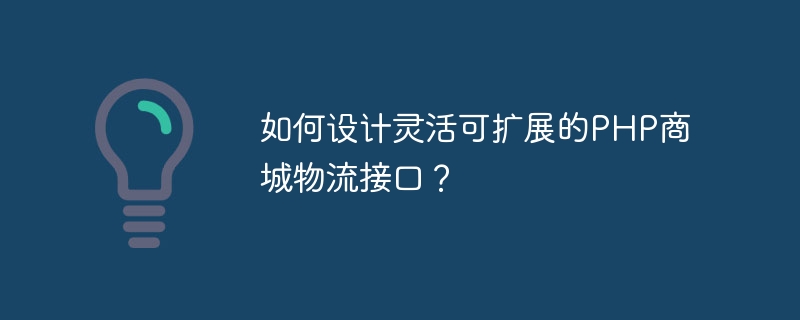
How to design a flexible and scalable PHP mall logistics interface?
With the rapid development of e-commerce, more and more companies choose to sell products online. And establishing a complete logistics system is a critical step to ensure timely delivery of products and customer satisfaction. This article will introduce how to design a flexible and scalable PHP mall logistics interface to meet the needs of different malls.
- Abstract interface design: When designing the logistics interface, the design of the abstract interface should first be considered. By defining abstract interfaces, the specific implementation of different logistics service providers can be separated from the logic of the mall system, improving the maintainability and scalability of the system. The abstract interface should include basic logistics operations, such as querying order status, generating waybills, printing express delivery orders, etc.
- Multi-channel support: Considering that different malls may choose different logistics service providers, we need to design a logistics interface that can support multiple channels. Information related to different logistics service providers, including API addresses, certification information, etc., can be managed through configuration files or databases. Corresponding adapters can be implemented in the interface for different service providers to support different channels.
- Exception handling and retry mechanism: When performing logistics operations, it is inevitable to encounter various abnormal situations, such as network failures, service unavailability, etc. In order to improve the availability of the system, it is necessary to design corresponding exception handling and retry mechanisms. Catch exceptions in the interface and handle them appropriately. You can record the error information in the log to facilitate subsequent troubleshooting.
- Interface documentation and testing tools: In order to facilitate mall system developers to use the logistics interface, detailed interface documentation and testing tools should be provided. The interface document should include the usage instructions, parameter descriptions and sample codes of the interface. Testing tools can help developers debug and test interfaces during the interface development process, and provide corresponding error prompts and debugging information.
- Plug-in mechanism and scalability: In order to achieve a flexible and scalable logistics interface, you can consider designing a plug-in mechanism. Define a plug-in interface in the mall system for third-party developers to develop customized logistics plug-ins. When the mall system loads the plug-in, it can obtain the plug-in implementation through the reflection mechanism and automatically register it in the logistics interface. In this way, the mall system can flexibly add new logistics service providers.
- Data security and permission control: When designing the logistics interface, data security and permission control need to be considered. By authenticating and authorizing the interface, only legitimate users can use the interface. In addition, encryption algorithms can be used to encrypt sensitive data to ensure data confidentiality and integrity.
In short, when designing a flexible and scalable PHP mall logistics interface, abstract interface design, multi-channel support, exception handling and retry mechanisms, interface documents and testing tools, plug-in mechanisms and extensions should be considered security, data security and permission control. Through reasonable design and implementation, the reliability and stability of the mall logistics system can be improved and adapted to the needs of different malls.
The above is the detailed content of How to design a flexible and scalable PHP mall logistics interface?. For more information, please follow other related articles on the PHP Chinese website!






